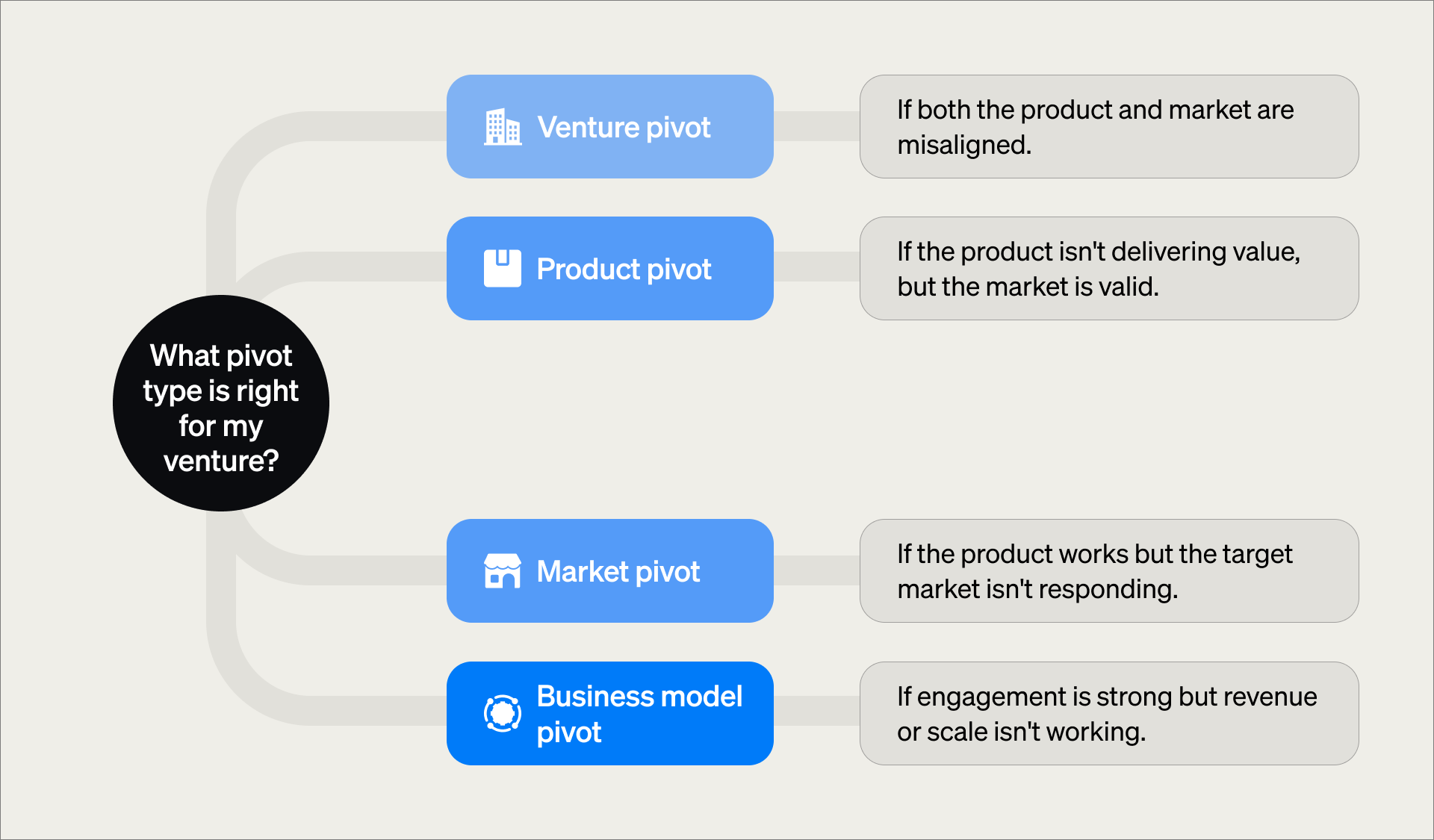Key takeaways
Knowing when to build, pivot, or kill a venture is one of the toughest decisions in corporate innovation. The risks are real, resources are limited, and pressure from stakeholders can blur even the clearest judgment. So, how do top innovators make these decisions with confidence?
Drawing from over a decade of venture building at Bundl and insights from senior innovation leaders in the Bundl Venture Club, this guide addresses the most pressing FAQs around build, pivot, and kill decisions, including:
- How to evaluate ventures using clear, stage-based criteria
- Signs that it is time to pivot or shut down
- Strategies to avoid sunk cost traps and emotional decision making
Whether you are validating a new idea or scaling an existing venture, these insights will help you act decisively, guided by data rather than just instinct.
Let’s get started.
Q. What does “Build, Pivot, or Kill” mean in corporate venturing?
A: It’s a decision-making framework used to evaluate whether a venture idea should be further developed (build), adjusted in a new direction (pivot), or shut down (kill). It helps corporate innovators allocate resources effectively based on performance signals.
Q. How do you map a venture for evaluation?
A: To evaluate a venture objectively, you first need to define what success looks like at its current stage. That starts with mapping the venture across three key dimensions:
- Age of the venture
- Current version of the product or achieved goal
- Contextual factors unique to the venture (e.g. internal resources, market dynamics)
These help position your venture on the venture lifecycle map, which includes stages like validation, incubation, acceleration, and scale.

By linking each stage to its expected milestones, you ensure that your evaluation is both contextual and objective (not based on arbitrary expectations). The best way to achieve this goal is by following a framework.
Q. How do you define success when evaluating a venture?
A: Success depends on where your venture is in its lifecycle. To evaluate effectively, you need to map the venture’s current position and ask:
- How old is the venture?
- What version of the product exists?
- What goal has been set for this stage?
- What context is specific to the venture or market?
These factors help place the venture on the venture lifecycle map, ensuring you evaluate it against realistic, stage-appropriate goals.
Q. How do you set up a framework to decide whether to build, pivot, or kill a venture?
A: To make smart venture decisions, you need a structured evaluation framework based on lean startup principles. This involves:
- Setting clear hypotheses
- Defining success metrics
- Mapping your venture across lifecycle stages
A venture’s lifecycle stages include validation, incubation, acceleration, scale and maturity.

Each decision point should be grounded in real market feedback, not gut instinct.
Q. How do venture lifecycle stages influence whether you build, pivot, or kill a venture?
A: Each phase of a corporate venture’s lifecycle comes with specific goals and success metrics that help guide whether to keep building, pivot, or shut down:

By understanding where your venture sits on this map, you can align decisions with real progress, rather than emotional bias or internal pressure.
Q. What criteria should you use to determine whether to build, pivot, or kill a venture?
A: Evaluate your venture across five key criteria:
- Market: Is there a real opportunity based on growth potential and competitive dynamics?
- Customer: Are you seeing strong engagement, retention, and meaningful usage?
- Product: Does it solve the core problem? Do users return or recommend?
- Team: Is your team capable, aligned, and fast enough to meet the next milestone?
- Financials: Can your revenue model, pricing, and runway support forward momentum?

Each layer acts like a signal, helping you decide whether to double down and build, make a strategic pivot, or kill the venture and reallocate resources.
Q. What metrics help guide the build-pivot-kill decision?
A: Leading metrics include customer acquisition cost (CAC), customer retention, conversion rates, Net Promoter Score (NPS), churn rates, and customer engagement. Lagging indicators like revenue and profit can also matter, but in early stages, validated learning is key.
Q. How do you set up the right metrics to guide build-pivot-kill decisions?
A: Start by grounding your metrics in lean methodology (build, measure, decide). That means every metric should be directly linked to a clear hypothesis tied to your venture’s current stage.
For each of the five evaluation criteria (Market, Customer, Product, Team, Financials), define stage-specific hypotheses and choose 3–5 metrics that reveal whether you’re moving toward your milestone or missing it.
For example:

Q. How do you know when to pivot vs. kill a venture?
A: Here’s a quick rule of thumb:
- Pivot if: You’re seeing signs of traction, but key assumptions (product, customer, market) aren’t holding up.
- Kill if: You’ve exhausted options, tried multiple pivots, and the core problem or market is invalidated.
Your goal is to preserve what’s working (e.g., team or learning) without dragging out unsalvageable ideas.
Q. What are the signs a corporate venture should pivot instead of being killed?
A: Consider a pivot when the team is strong and the problem space is valid, but the current solution, market segment, or business model isn’t working. Pivots are about learning from early failures and adjusting direction without having to start from scratch.
Q. Until when can you pivot a corporate venture?
A: You can pivot up until you’ve achieved Product-Market Fit (PMF). Before PMF, pivots are common and expected, driven by early signals like buyer intent, feedback, or usage patterns.
After PMF, the focus shifts from validation to scaling, and changes are no longer seen as pivots but as strategic adjustments or repositioning. At this stage, larger pivots, especially venture pivots, may feel more like a restart or even a potential kill decision.
Key distinction:
- Pre-traction: Pivots are learning-driven (e.g. product or market pivots)
- Post-traction: Pivots carry more weight and can impact the viability of the entire venture
Q. What are the most common reasons to pivot a corporate venture?
A: Common reasons to pivot include:
- Low buyer intent: Market interest isn’t strong enough to support growth.
- Weak customer feedback: Poor reviews, low engagement, or unclear product value.
- Low retention: Users drop off quickly or don’t return.
- Stagnating growth: Usage or revenue plateaus despite effort.
- High competition: The market is saturated or dominated by better-positioned players.
- Misaligned market-product fit: The solution works, but not for the intended audience.
The specific reason often depends on the stage:
- Early stages: Focus on problem-solution fit.
- Later stages: Focus on scale, economics, and sustainability.
Q. What are the different types of pivots in corporate venturing?
A: There are four main types of pivots used in corporate venturing, each designed to help teams adapt when core assumptions don’t hold true.
- Product Pivot
Change what you’re offering, either by improving the core product or replacing it entirely.
Use this when the market exists but the product isn’t resonating with customers.
- Market Pivot
Shift your focus to a different customer segment or use case.
Use this when the product works, but the target audience isn’t responding.
- Business Model Pivot
Change how you generate revenue through pricing, distribution, or monetisation strategies.
Use this when users engage, but the venture isn’t financially sustainable.
- Venture Pivot
Start over by rethinking both the product and the market.
Use this when both core assumptions are invalidated and learning has been exhausted.

Q. How do you know which type of pivot to use for your corporate venture?
A: The type of pivot you choose depends on which part of your venture is underperforming. Start by assessing:
- What’s been validated and what hasn’t
- Where users drop off or disengage
- Whether you’ve reached any stage-specific goals (e.g. retention, revenue, referrals)

Q. What are the next steps after pivoting a corporate venture?
A: Once you’ve decided to pivot, the key is to treat it as a strategic move, not a reset. What you do next depends on whether your venture had traction or not:
- If you’ve gained traction (incubation or acceleration):
- Define the pivot’s scope—what’s changing and what’s staying
- Update your success metrics to reflect the new direction
- Communicate clearly to align your team and sponsors around the new goals
- If you haven’t gained traction (validation phase):
- Use the pivot matrix to identify which type of pivot fits
- Focus on building new hypotheses and re-testing fast
In both cases, you should:
- Document what you’ve learned and why the pivot was made.
- Communicate the strategic rationale, internally and to key stakeholders.
- Reinforce team alignment, so everyone understands how the pivot supports the venture’s long-term value.
Remember, pivots aren’t a sign of failure; they’re a strategic move to turn insight into momentum.
Q. How can you avoid killing a venture too early or dragging it on too long?
A: Use a hypothesis-driven evaluation loop instead of one-off decisions. Set clear success criteria upfront, review progress at defined intervals, and make calls based on data, not gut feeling or sunk costs.
This continuous feedback approach helps you decide whether to build, pivot, or kill at the right time, by showing if the venture is truly on track or just burning resources.
Q. When should a corporate venture be killed?
A: A venture should be killed when key success metrics show persistent negative trends despite multiple pivots, such as a lack of product-market fit, low customer engagement, or inability to reach scalable economics. Kill decisions are about focus and freeing up resources for stronger bets.
Q. How often should venture performance be reviewed?
A: Regular check-ins are critical. Monthly sprints, accompanied by quarterly milestone reviews, are common. Each review should be tied to specific hypotheses and key performance indicators (KPIs), not just arbitrary timelines.
Q. What mindset should corporate innovators have around killing ventures?
A: Killing a venture isn’t failure, it’s progress. In high-performing innovation environments, kill decisions are signs of discipline and strategic focus. Celebrate the learning, not just the wins.
Q. Who should be involved in the decision to build, pivot, or kill a venture?
A: Ideally, the decision should involve a mix of internal and external stakeholders: the venture team, corporate sponsors, and independent innovation leads or venture board members. This balance helps ensure decisions are both data-driven and aligned with strategic goals.
Q. How can we make “kill” decisions less political inside the company?
A: Use transparent criteria, pre-agreed success metrics, and data-led reviews. Framing “kills” as portfolio decisions helps teams and sponsors understand it’s about managing risk, not punishing failure.
Final thoughts
Every venture reaches a point where decisions need to be made. The challenge is not just in choosing what to do next, but in knowing when to act and why.
There is no single blueprint for success, but with clear criteria, stage-appropriate metrics, and a mindset rooted in learning, teams can move forward with greater focus and less guesswork.
The goal is not to avoid failure entirely, but to make better decisions faster, and to ensure each step, even a pivot or shutdown, moves the organisation closer to long-term value.
—
Want to know how top corporates make build, pivot, and kill decisions? Join 300+ senior innovation leaders at Bundl Venture Club to explore real venture cases, proven frameworks, and live session insights to help you make better calls, faster. It’s free.
5 Failed Venture Studios, Examined
Discover the lessons gained from analysing failed venture studios in this report








